A Growing Problem
Leaffooted plant bugs posing bigger threat to tree nuts
Acouple of species of leaffooted plant bugs are commonly found in California tree nuts, Leptoglossus zonatus and Leptoglasses clypealis. Historically, they have not been that big of a problem, at least not in comparison to other pressures that growers face.
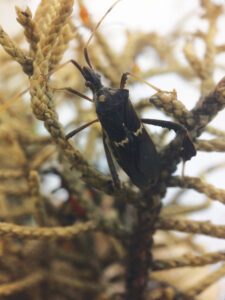
During the last decade, however, there has been an increase in reports of damage by leaffooted plant bugs, and now it is becoming an issue.
FROM CROP TO CROP
Broadly speaking, in California, these insects overwinter as adults in large aggregations, typically in sheltered locations, such as riparian habitats, residential areas, brush piles or citrus. When it gets warmer in the spring, and days get longer again, they move into native vegetation. As nuts and fruit develop, they colonize nut orchards and other crops such as pomegranates.
They feed by inserting their tube-like mouthparts into plant tissues and inject saliva, which helps break down the tissue, and they suck up the resulting liquid. The nutrient- rich developing almonds provide a good food source. The insects feed until the shells start to harden and become more difficult to penetrate.
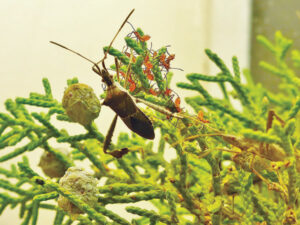
Then the insects move on to the next crop. These bugs will feed on pistachio, roughly around June, until the same sequence of events occurs: the shell hardens, and the insects cannot penetrate it to feed.
The insects then move on to the next crop: pomegranate, where they will likely finish out the season before returning to overwintering in large aggregations. Researchers at University of California-Riverside’s Department of Entomology and European collaborators have been researching the chemical signals used by leaffooted plant bugs, specifically the species Leptoglossus zonatus and Leptoglossus occidentalis.“They feed on other plants as well, like vegetable crops and certain weeds,” said UC-Riverside researcher Houston Wilson. “Some growers have had experiences where neighboring open fields have grasses that will be mowed or dried out or killed, and they’ll see a flush of leaffooted bugs move into their orchards.”
Methods for monitoring leaffooted bugs are currently limited. Right now, canopies are sampled with a beating tray — placing a tray underneath and hitting the canopy to see what falls out. This method is time- and labor- intensive, and there aren’t established recommendations for sampling, such as how many trees, how often or what constitutes a large enough infestation to require treatment.
Decisions frequently are made based on signs of damage — looking at the nuts and checking to see if there is gummosis. While gummosis can be caused by a number of things, if the nut is cut open and shows signs of penetration of the bug’s mouth parts, this verifies that the damage was caused by leaffooted or related plant bugs.
“It’s problematic because it’s all after the fact,” Wilson said. “And we currently don’t have a recommendation of how many damaged nuts is a threshold for making a decision about treatment.”
When growers see damage, they’re going to spray, Wilson said, but it’s often with historical knowledge working in their favor because some orchards become infested year after year. Previous observations keep some growers alert to problematic fields.
But growers can miss these pests because bugs can move into an orchard very quickly. Every year, Extension and pest control advisers receive calls from growers who get inundated unexpectedly.
“And when there’s that much damage to the nuts, they fall from the tree, and that’s going to have an impact on yield,” Wilson said. “For these reasons, we needed a new tool for monitoring.”
With these species groups, the males emit a pheromone that attracts females, along with other chemicals used in defense and those produced during courtship and mating.
With this information, researchers needed to do two things: 1) identify and develop a pheromone lure, and 2) build a trap to put it in. But they faced a Catch 22. How do they test which trap is best if they do not yet have an attractant lure to put in it? And conversely, how would they test lures if they don’t have a good trap?
“We did some work early on in some highly infested orchards where we put out different trap types that might be suitable for this type of insect. And we were able to generate some clear data that a particular type of trap was effective,” said Wilson, whose team also evaluated trap colors and Teflon-based lubricants that make the traps more slippery so that the insects fall in.
The optimal trap was found to be a cross-vane hanging panel trap. These traps can be hung in the orchard, and when an insect lands on a lubricant-coated trap, it falls into liquid in the trap bottom and drowns.
THE SCIENCE OF PHEROMONES
Professor Jocelyn Millar, supervisor of a laboratory in the Department of Entomology at UC-Riverside, and his lab members captured the pheromone being emitted by sexually mature male bugs and analyzed it with a gas chromatograph- mass spectrometer (an instrument that separates chemical mixtures and provides information about their structures) to help identify the possible components of the pheromone.
In parallel, they used gas chromatography coupled to electroantennogram assays, which use a live insect antenna as a detector. These assays show exactly which compounds in an extract the antenna is most sensitive to, i.e., the components which are most likely to be pheromones. The researchers can then focus their identification efforts on those components.
However, one drawback of this type of assay is that it only shows that the insect detects the chemical. It does not indicate whether the chemical is an attractant or a repellent.
“What we ultimately found is that this pheromone might contain as many as nine different compounds. After we identified each of these compounds, we subsequently needed to figure out a process to synthesize them in quantities sufficient for field testing,” said Wilson.
THE HIDDEN COMPOUND
Millar and his team were able to identify a hidden compound that barely showed up on the gas chromatograph but elicited a very strong response from bug antennae in electroantennogram assays and was therefore likely to be a key component of the pheromone blend. However, it was only present in small amounts as part of a mixture of many other compounds, and it was a compound new to science.
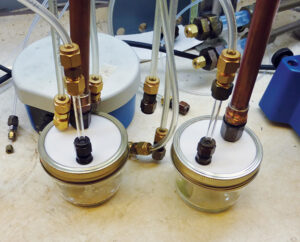
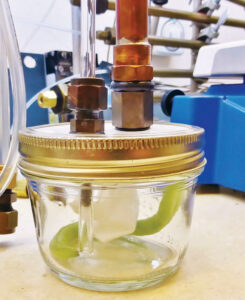
Thus, the researchers had to collect extracts from numerous cohorts of sexually mature male bugs for more than a year to isolate sufficient amounts of the compound to tentatively identify it by nuclear magnetic resonance spectrometry. To conclusively prove the identification, they had to synthesize the compound, making enough for field testing.
With the compound finally in hand, the team gave it the name leptotriene.
Wilson received a box of the first five lures to put out in the field, where the rubber meets the road.
“It was like, ‘Holy cow, we’ve got to get this right,’ ” he said, because in total, this represented several years of work.
The lures showed that leptotriene was the key component of the pheromone blend, and leptotriene alone in the hanging panel traps was attractive to leaffooted bug females.
Since those first trials, the team has been working to improve the efficiency of the synthesized lure, because it can only be commercialized if it can be produced at scale and at an affordable price.
There are also a number of field experiments underway to look at leptotriene on its own as well as in combination with the other eight compounds of the blend, to determine the subset of compounds that are both necessary and sufficient for optimal attraction.
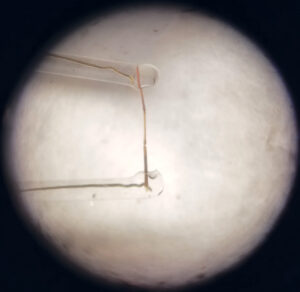
The more components are in the blend, the more expensive it will be, and so the team is trying to find a combination that will provide strong attraction with a relatively small number of components. Field trials planned for the coming season will focus on identifying this optimal blend through a series of iterative trials.
This year will be the seventh and last year to wrap up the project and deliver a practical monitoring system to the grower groups who have supported the research.
“It’s been a long road, but it’s really important work, and we’ve steadily made progress each year,” Wilson said.
A TEAM APPROACH
Information about the identification and synthesis of leptotriene was published in July 2022. By making the information public, it is freely available to companies that produce pheromone products. An American company has already synthesized leptotriene using Millar’s route, and the team plans to work with the company to move pheromone lures for Leptoglossus species from the research phase to a practical commercial product, readily available to growers. Many members of the Millar lab contributed to chemistry work, including:
- Professor Jocelyn Millar(identification of the compound, determination of the synthetic strategy to use and overall supervisor of the lab)
- Dr.Yunfan Zou (carried out and optimized the synthesis of leptotriene)
- Dr. Sean Halloran (reared the insects, prepared and analyzed pheromone extracts using gas chromatography-mass spectrometry and gas chromatography- electroantennographic detection
- Dr.TessaShates(graduatestudentwhohelped field collect insects and carried out volatile collections for her first two years)
Essential collaborators for field work are:
- Dr. Houston Wilson (collected bugs to start lab colonies and carried out all the field trials)
- Dr. Kent Daane (collected bugs to start lab colonies and advised on all field work)
In addition, the California team joined forces with Professor David Hall of Greenwich University in the U.K., and his Spanish collaborators Professor Juan A. Pajares and student Laura Ponce-Herrero, to work on the pheromone for the related Leptoglossus occidentalis, which also turned out to use leptotriene as a pheromone component. Leptoglossus occidentalis is native to North America, but it has invaded Europe, where it is causing major damage in crops such as edible pine nuts.







